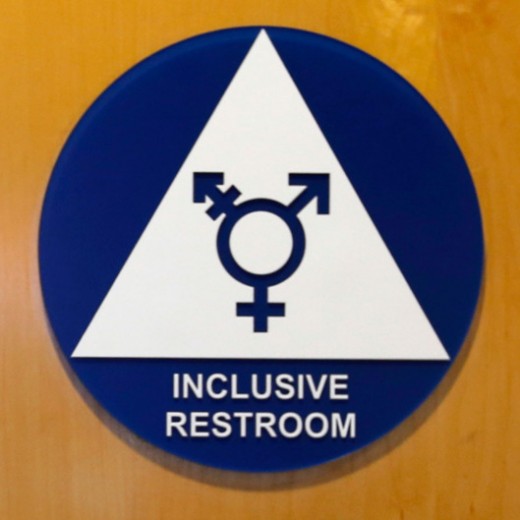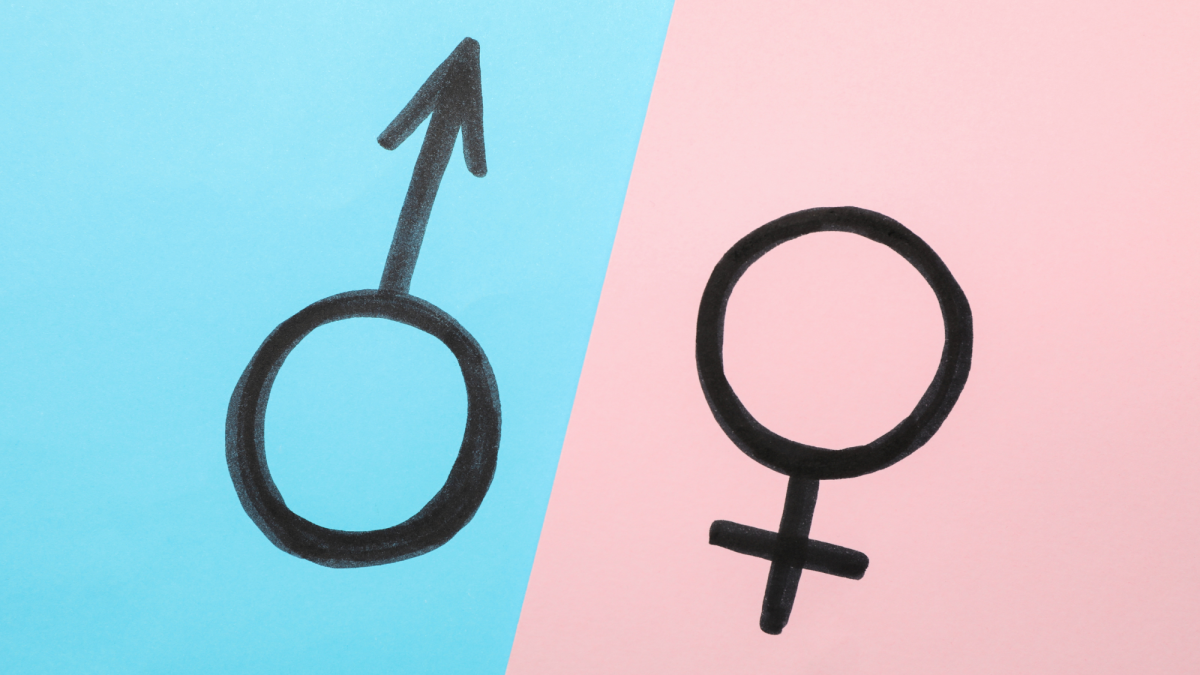Bathroom Laws: NC HB2 and Use of Restrooms by Transgender Persons
Inclusive Restroom Symbol

Background
On February 22, 2016, in North Carolina the Charlotte City Council passed an ordinance that prohibited various kinds of discrimination including discrimination based on gender identity in public accommodations. Many people viewed this ordinance as allowing trans men to use public facilities for women and trans women to use public facilities for men. By “public facilities” here I mean public single-sex, multiple-occupancy restrooms, locker rooms, changing rooms, and such. That is, the ordinance was interpreted as making meaningless the idea of separate multiple occupancy public facilities for the two sexes.
On March 23, 2016, the North Carolina legislature reacted to the Charlotte ordinance by passing a bill (House Bill 2 or HB2) that among other things required people to use the public restrooms corresponding to their physical sex as shown on their birth certificates. Both republicans and democrats voted for the bill in the NC House, and both republicans and democrats voted for it in the NC Senate. On the same day, March 23, 2016 North Carolina Governor Pat McCory signed the bill into law.
House Bill 2 is officially titled “An Act to Provide for Single-sex Multiple Occupancy Bathroom and Changing Facilities in Schools and Public Agencies and to Create Statewide Consistency in Regulation of Employment and Public Accommodations.” It is often informally called “The Public Facilities Privacy & Security Act.” I shall refer often to it as simply “NC HB2”.(see “General Assembly of North Carolina” in “Works Cited” for the text).
Public Multi Occupancy Restrooms
Do you believe that there should be separate public multi occupancy restrooms for males and females?
Public Multi Occupancy Shower Rooms
Do you believe that there should be separate public multi occupancy shower rooms for males and females?
Reaction to NC HB2
The reaction to North Carolina's HB2 has been amazing. Performers and businesses have threatened to boycott the state. It is big news in print news media and on television news shows and opinion shows. It is the subject of magazine articles. Then the U.S. Attorney General weighed in with threats to withhold federal funding to North Carolina schools. And on May 13, President Obama got in the act and issued executive guidance on the subject to all the public schools in the nation. He told the nation's schools that they should allow students to use the bath rooms of the gender they identify with.
Exceptions Made in NC HB2
It is important to realize that NC HB2 allows a number of exceptions to the basic rule of only one sex allowed in a single-sex multiple occupancy bathroom or changing facility. These are as follows:
-
Custodial purposes
-
Maintenance or inspection purposes
-
To render medical assistance
-
To accompany a person needing assistance
-
Where the facility has been temporarily designated for use by the other sex
I think the exception “To accompany a person needing assistance” would include the able assisting the disabled, a father taking his young daughter (say, under six) into the men's room, or a mother taking her young son (say, under six) into the women's room.
Scope
In this essay, I make no attempt to consider or evaluate all of the provisions of NC HB2. My scope is limited to the issue of the use of single-sex multiple occupancy public facilities, as defined above, by persons of the “wrong sex,” that is, males using such facilities designated for females, and vice-versa, where such use is not one of the exceptions in NC HB2.
Definitions
In this essay I will use the following terms in the sense indicated:
“sex” – a biological condition; animals have it; for humans it is the condition of being male or being female. Males and females have different roles in reproduction and hence have different body parts for reproduction. Males have penises and testicles and females have vaginas, uteruses, and mammary glands.
“gender” – a social construct that relates to sex. It is a construct by society of the attitudes, roles, and traits that society associates with being male (masculinity) or being female (femininity). The construct of gender may be normative. For example, a “man” should be physically courageous and a “woman” should be nurturing. Or, the construct may be descriptive (at least in intention). For example, “men do not show emotion as much as women” and “women show emotion more than men.”
“gender identity” - a psychological condition. To say one's “gender identity” is female is to say that one identifies with having the attitudes and traits society associates with being female and that one wants to play the roles society associates with being female. The gender identity of a person may or may not correspond to their sex. Persons of the female sex may have a gender identity of female and persons of the male sex may have a gender identity of female. Similarly, persons of the male sex may have a gender identity of male and persons of the female sex may have a gender identity of male.
“transgender” – an adjective describing a person whose gender identity is different from his or her sex. We speak of “transgender persons,” not “transgendered persons.”
“transgender male,” “trans male,” “transgender man,” and “trans man” – a person born female whose gender identity is male.
“transgender female,” “trans female,” “transgender woman,” and “trans woman” – a person born male whose gender identity is female.
Numbers Count
According to the Wikipedia article “LGBT demographics of the United States” transgender persons are 0.3% of the population. That would be 3 trans gender persons in 1,000 persons. Numbers count because they provide needed perspective.
I recognize that there are difficulties in gathering statistics about transgender persons. However, perspective is needed, especially when policy is an issue, and so one must obtain the best statistics available, which I believe are found in the Wikipedia article cited above.
Much of the discussion about transgender persons and their use of single-sex multiple occupancy restrooms considers students in grades K-12. I think one can presume that the population of transgender students is no greater than 0.3% of the total student population. However, it may be less at different stages in development in those years. There may be differences in prepubescent students and also in post-pubescent students from the adult population. In absence of statistics on these matters, I assume that the 0.3% figure holds good for minor students. Hopefully, someone at sometime will gather reliable statistics on minor transgender persons.
Analysis
Warning: We need to be clear about what identifies a person as male or female. Clarity requires being explicit about those physical parts of the body that differentiate males and females.
The primary question to ask to understand the issue is this: “Why do we have separate public rest rooms and locker rooms for girls and boys, women and men, females and males?”
This custom of separate restrooms and locker room for the two sexes is long standing. Yes, there are some situations in which the public restrooms are unisex. The rest rooms on airplanes and long distance buses are unisex. Also, the offices of doctors and lawyers are often unisex. However, these kinds or restrooms are for occupancy by one person at a time, with the understandable situation of parents tending to the needs of their little children, who may be of the opposite sex from themselves.
The next question is this: “Why did this custom of separate restrooms for the sexes arise; that is, what purpose does it serve?”
I think the answer is clear: Because most people wanted it that way.
Females especially want their own public restrooms and locker rooms. Why? One reason seems to be fear of molestation by males, who certainly are more likely to molest them sexually than other females. However, I suggest that is not the fundamental reason. For example, in elementary school, I doubt that little girls are afraid of little boys trying to rape them. I suspect most little girls have only a vague idea of what rape is. I think though that little girls would prefer not to have little boys in their restrooms because little boys are, well, rude, crude, and annoying. But also they want privacy. I suggest then that the fundamental reason is a desire for privacy from the “male gaze” and perhaps accompanying comments. In public, most females are “modest” around males. They don't like the idea of their private parts being on public view, even to other females, but especially to males, known or unknown. Privacy is recognized by the Supreme Court as a right implied in the Constitution. (“Griswold”). Also, I believe females also are more likely to be embarrassed by certain sounds that occur when they are “doing their business.” In short, most females want visual and auditory privacy from males.
Thus, the custom of separate restrooms for the sexes arose because most people wanted it that way and it served the social purposes of providing wanted privacy, psychological comfort, and security. The providing of wanted privacy is, I believe, the most important social purpose because the very presence of a male in a public ladies room is always discomforting to most women whereas the incidence of molestation is low.
I think all this is obvious to most people.
So, from the above, the following is “a given”:
(R1) There should be separate public restrooms, gym locker rooms, pool changing and showering rooms and such for females and males where most of one or both sexes want it that way.
Given this, two things are obvious:
(R2) There should be rules against one sex using the public facilities of the other sex. If you have a public restroom for females, only females should use it and that must be understood by all. It doesn't make sense to say that one provides separate restrooms for males and females but males can use the restrooms for females any time they want to and females can use the ones for males any time they want to.
(R3) One needs to define “female” and “male” Unless one knows what it is to be female or male, one cannot very well have separate restrooms for males and females and prohibit a male from using the restrooms of females and females from using the restrooms of males.
The terms “female” and “male” are terms of sex. Sometime around the late 1960s or early 1970s, feminists introduced the term “gender.” The difference between “sex” and “gender” is that the former is a biological concept and the latter is a social construct. Nowadays though, many people seem to use the term “gender” where they once would have used the term “sex.” They use it to mean “sex”. The important thing here is that the custom of having separate public restrooms for females and males came into being before talk about “gender” and the custom was based on sex; that is, on whether a person was a biological female or a biologically male. The custom also arose before people thought in terms of “xx” and “xy” chromosomes, biological females possessing the former and biological males possessing the latter. In short, the custom was based on sex which meant it was based on whether one physically had a penis or one physically had a vagina. The rule is: (R4) If a person has a penis then that person is a male, a “he”; but if a person has a vagina then that person is female, a “she.”
At this point, I think we should consider the significance of “sex change” medical procedures.
I take the meaning of “sex change operation” at face value. That is, if a person has a sex change operation then the accepted sex of that person has been changed; that is, if before the operation the person was male, then she is now female, but if the person was female, then he is now male. I should say that by “operation” I do not mean something singular but more likely a set of sequenced medical procedures. I believe that society (most of it anyway) accepts that the person's sex has been changed in the sense that society will treat the male changed to female as female and the female changed to male as male (“she” becomes “he”). Moreover, I believe that the law in most if not all states accepts that a person's sex has been changed as a result of a sex change operation. Certainly, North Carolina law does, as we shall see later on.
Thus, we should add the rule:
(R5) A person born male can legally be regarded as female if he had a sex change operation to become female, and a person born female can legally be regarded as male if she had a sex change operation to become male
Let us review:
-
The custom of separate public bathrooms for the two sexes arose because people wanted it that way, especially, I think, women. The custom serves the social purposes of privacy, psychological comfort, and security, with privacy being the main reason.
-
Thus, (R1) there should be separate public bathrooms for the two sexes in situations where they want it.
-
(R2) We need a rule against one sex using the public facilities of the other sex.
-
(R3) To establish such a rule we need to be able to tell who is a female and who is a male.
-
(R4) The sufficient conditions for knowing if a person is male or female is this: If a person has a penis then that person is a male, a “he”; but if a person has a vagina then that person is female, a “she.” (Please note, we are not defining “male” and “female” but simply providing easily observable conditions for knowing one from the other, if the issue should arise.)
-
(R5) Sex change operations do change a person's sex.
From the above, I think we can conclude the following rule for the use of single-sex multiple occupancy public facilities such as restrooms, locker rooms, changing rooms, and the like:
(R6) If a person has a penis then that person is allowed to use the single-sex multiple occupancy public facilities designated for males but not for females; however, if a person has a vagina then that person is allowed to use the single-sex multiple occupancy public facilities designated for females but bit for males (except for some common-sense exceptions such as those identified in NC HB2).
Are there possibilities not covered by R6? Probably the most common possibility is a man who has had his penis cut off but still should be regarded as a man. This might happen for any number of reasons. One is that he had penile cancer and it was amputated for that reason. Another is being wounded in the groin while performing military service. I'm sure that R6 could be modified to include such cases, but the number of cases is so tiny that I don't see any reason spend much effort in doing so. However, I will say that I believe one would start with making a distinction between willingly undergoing a sex change operation and a man losing his genitals through criminal action, accident, or physical medical necessity.
It should be noted that rule R6 is consistent with rule R5, which allows that one can be born one sex but through a sex change operation legally become the opposite sex.
The rule R6 can be simplified as follows:
(R7) If a person is physically male then he may use the single-sex multiple occupancy public facilities designated for males but not for females; however, if a person is physically female then is allowed to use the single-sex multiple occupancy public facilities designated for females but not for males (except for some common-sense exceptions such as those identified in NC HB2 and listed above).
Comparison of My Analysis and NC HB2
NC HB2 defines “biological sex” as “The physical condition of being male or female, which is stated on a person's birth certificate.” (NC HB2, Sections 1.2 and 1.3) To me, this is saying physical condition is the primary determiner and person's birth certificate is the secondary determiner.
My rule R4 agrees with NC HB2 that a person's physical condition of being male or female is the primary determiner of a person's sex. NC HB2 adds the birth certificate provision, which has the advantage of being less invasive of privacy.
My rule R5 is that a person can have his or her sex changed through a sex change operation. The State of North Carolina recognizes this also and allows for a person's sex on a birth certificate to be changed if that person has had a sex change operation. On this issue Lambda Legal cites the relevant North Carolina Statue:
Statute: N.C. Gen. Stat. §§ 130A-118(b)(4), (e) (2005).
Text: (b) A new certificate of birth shall be made by the State Registrar when . . .
(4) A written request from an individual is received by the State Registrar to change the sex on that individual's birth record because of sex reassignment surgery, if the request is accompanied by a notarized statement from the physician who performed the sex reassignment surgery or from a physician licensed to practice medicine who has examined the individual and can certify that the person has undergone sex reassignment surgery. (Lambda Legal)
Issues of Enforcement
Many people seem to be concerned about how we are to enforce any rule (law, ordinance, whatever) that says only males are allowed to use single-sex multiple occupancy public facilities designated for males and only females are allowed to use single-sex multiple occupancy public facilities designated for females, with the exception of common-sense exceptions such as those noted above. They argue that a law such as NC HB2 is not enforceable and that a law that is not enforceable is not a bona fide law.
These concerned people ask bizarre questions such as, “Must we now have gender surveillance?” “Will public restroom entrances have to be monitored?” “Will sex/gender compliance officers be needed at entrances to public restrooms?” “Will people have to produce birth certificates or other documentation to prove they are going into the right restroom? “If people cannot produce the required documentation, will they have to submit to a physical inspection before being allowed to go in and pee?
All these questions are diversionary. They are scare tactics. They are silly.
The fundamental issue as I have indicated is, “Are we to have single-sex multiple occupancy public facilities? Custom, which I take to be in effect the voice of the people as to what they want, says “Yes.” If you answer “No,” then you are saying there should be no single-sex multiple occupancy public facilities' that is, all multiple occupancy public facilities, as defined above, are to be open to and used by members of both sexes.
Now, we have had for a long time single-sex multiple occupancy public facilities and we have not had restroom sex/gender surveillance or monitoring and all the other silly stuff.
So, what's the problem?
I don't see one.
The issues of enforcement raised by the opponents to NC HB2 focus on prevention. For example, how do we prevent a physical male who identifies as a female from entering into and using a multiple occupancy restroom designated for females? We do so in the same way we prevent any physical male from doing so. We don't. We do not now prevent physical males from entering into restrooms for females. But we do discourage through punishment of transgression.
In my elementary school back in the late 1940s, if a bad boy entered into a girls restroom the most likely scenario was as follows: the girls shrieked, a teacher appeared who took charge of the bad boy and took him to the principle, the principle scolded the boy, perhaps spanked him, surely called the boy's parents, and may have kept him after school. I suspect that the actions taken by the teacher and the principle were not encoded in any state statue but a matter of local school policy. But that is not the main matter, which is that the enforcement dealt with transgression and not prevention.
Rape, urination in public, and indecent exposure and just a few of the many rules or transgression that where “enforcement” is not prevention but punishment after the transgression. Just as males entering without cause into restrooms is more likely than the opposite, so rape, urination in public, and indecent exposure are more like to be male transgressions. In all such cases, after a transgression has occurred, it may or may not be detected (e.g., urination behind bushes or even out in the open with no one around). Even if detected it may or may not be reported. Even if reported the police or other authority, they may or may not apprehend the transgressor. Even if the transgressor is apprehended, the transgressor may or may not be tried and if tried the transgressor may or may not be convicted and punished.
As we enforce most laws, so we will enforce, and have enforced, rules about use of single-sex multiple occupancy public facilities. We will not prevent transgression but try to punish transgressors in the hope that will deter transgression.
The Issue of Safety
Advocates for persons using public facilities based on their gender identity often say it is a matter of safety for these persons. But there assertions are vague and lack specificity.
On Monday, May 16, 2016 President Obama said,
We’re talking about kids, and anybody who’s been in school, been in high school, who’s been a parent, I think should realize that kids who are sometimes in the minority — kids who have a different sexual orientation or are transgender — are subject to a lot of bullying, potentially they are vulnerable,” Mr. Obama said in an interview with BuzzFeed News. “I think that it is part of our obligation as a society to make sure that everybody is treated fairly, and our kids are all loved, and that they’re protected and that their dignity is affirmed.(Hirschfeld, “Obama Defends”)
President Obama doesn't explain how allowing transgender students to use the bathrooms of their gender identity will protect them. How is a physical female with a male gender identity protected if that person uses a restroom for males? May that person not be subject to verbal and perhaps even physical abuse in the restroom for males? A physical male with a female gender identity may not fare any better if he uses a restroom for females that is full of “mean girls.” Mr. Obama acknowledges that there is “a lot bullying” of transgender students but he doesn't explain why they are safer in restrooms of their gender identity. It may be that transgender students using the restrooms, locker rooms, shower rooms, and such facilities of their gender identity rather than their biological sec actually put themselves at greater risk than if they used the restrooms of their physical sex. A lot, I think, would depend on their behavior rather than their psychological identity. Mr. Obama also doesn't explain how transgender students are protected outside restrooms, that is in hallways, staircases, cloak rooms, nooks and crannies, going to and from school, etc. These situations are more common that that of using restrooms.
When I was in the sixth grade, the tallest, heaviest, meanest, and most aggressive student in my class was a girl. Rumor was that she had been held back from promotion for years and that was why she was so big. She liked to bully, to provoke fights, to throw her victims to the ground, to sit on them and to punch them. Her victims were female and male. She didn't discriminate. I suspect she would have loved to catch a trans female alone in the confines of the girl's room. How would Mr. Obama's guidance to schools protect the little trans female. Mr. Obama's fine words about protection wouldn't help the trans female at all.
Bullying – physical, verbal, and in online social media – is a big problem in many of our schools. Transgender students are a very small part of those being bullied. The problem transcends the transgender issue. The problem is best handled by the local school districts and the states, without federal government interference. Mr. Obama's fine words about protection of students from bullying is inadequate, over-reaching, and misplaced
Transgender persons are a tiny part of our population—about 0.3%, that is, about 3 in 1,000 (Wikipedia “LGBT demographics”). Many schools would not have any transgender students and most of those that do might have just 1 or 2. Such a small number can easily be accommodated through the use of (1) single-occupancy restrooms, (2) multiple occupancy restrooms just for transgender students, or (3) facilities for the faculty. NC HB2 allows for these accommodations. It allows local schools to establish multiple occupancy restrooms just for trans males or just for trans females. Also, NC HB2 allows local schools to provide single occupancy restrooms that transgender students can use. And it allows schools to let transgender students use faculty facilities on request. Thus, NC HB2 allows for more accommodation and flexibility than Mr. Obama's one-size-fits-all guidance to public schools nationwide. By doing so, it potentially allows for more safety for transgender students—at least in restrooms. (For further discussion on this viewpoint about the greater accommodation of NC HB2 over the Obama administration's guidance to the nations public schools, see Siggins).
Issues of Discrimination
Attorney General Loretta Lynch said, "There is no room in our schools for discrimination of any kind, including discrimination against transgender students on the basis of their sex." (Gringberg)
Ms. Lynch uses the word “discrimination” not in its basic, simply descriptive sense of treating differently but in the normative sense of unjustified treating differently. Using the word “discrimination” to mean “unjustified discrimination” opens the door for equivocation and sophistry. The word “discrimination” today usually carriers negative connotations. For many people, just to point out to them that there is discrimination (treating differently) leads them to assume harmful unjustified discrimination, when such may not be the case. Many automobile nsurance companies charge young men higher auto insurance policies than young women and this is treating differently based on sex and hence discrimination based on sex, but this practice is apparently regarded as justified discrimination in the law.
Further, Ms. Lynch is wrong when she says “[t]here is no room in our schools for discrimination.” It is fairly common throughout the nation that if a school has a wrestling team for boys and none for girls and a girl wants to wrestle on a wrestling team, then she is allowed to do so. However, if a school has a volley ball team for girls and none for boys and a boy wants to play on a volley ball team, he is not allowed to play on the girls teams and so he does not play at all. Clearly boys and girls are treated differently in this regard and so there is school supported discrimination but in the law it apparently is justified discrimination.
Most of the supporters of transgender individuals using the bathrooms of their gender identity make little attempt at arguing their case. They appeal to emotion or simply declare that it is discriminatory (without justification) to require transgender individuals to use the restrooms of their physical sex rather than their gender identity.
We expect more from the U.S. Department of Justice. According to CNN,
The Justice Department said last week that "access to sex-segregated restrooms and other workplace facilities consistent with gender identity is a term, condition or privilege of employment. Denying such access to transgender individuals, whose gender identity is different from their gender assigned at birth, while affording it to similarly situated non-transgender employees, violates Title VII," a section of the Civil Rights Act prohibiting discrimination against workers on the basis of sex, race, color, national origin, and religion. (Sterling)
The statement by the Justice Department was a response to NC HB2. It is to be noted that Title VII prohibits discrimination of the basis of sex, not gender identity. It seems that the Justice Department is making law here, rather than administering it.
Moreover, the Justice Department refers to “gender assigned at birth,” which means the sex that a person has at birth. The language here is inaccurate, subjective, and opens the door for illogical thinking based on equivocation and conflating of distinct concepts (gender and sex). Gender is social construct, something created and sustained by society. A baby's sex is not a social construct, but what it is, something physical, something biological. Moreover, according to the Justice Department sex is “assigned” to a baby. That implies an assigner and there is no assigner of sex when a baby is born. Moreover, to speak of an “assigner” implies there can be reassignment. Supporters of trans people telling use the phrase “sex reassignment operation” in place of “sex change operation.” The misuse of “gender” and “assign” in this fashion substitutes subjectivity for objectivity and removes us from reality.
We should also note that although gender and sex are two different kinds of things, the former a social construct (and psychological condition) and the latter a biological condition, there is widespread usage of the word “gender” to mean “sex.” Again, this conflating of distinct concepts opens the door for illogical thinking, or more probably, closes the door for any real thinking on the issues here.
For example, if it is wrong to always discriminate on the basis of sex, and if gender and sex are the same, and if gender identity and gender are the same, then it is always wrong to discriminate on the basis of gender identity. This is a logically valid line of reasoning of the pattern “If A is B and B is C, then A is C”. However, it is not a sound argument because none of the premises are true. (1) It is sometimes justified to discriminate on the basis of sex. Examples: affirmative action that helps women, conscripting men into military service but not women, and charging higher automobile accident insurances premiums for young men (Note: some of these examples may be problematical but they are currently regarded as justified acts of discrimination.) (2) Gender and sex are not the same. (3) Gender identity and gender are not the same and so you may not use the word “gender” to mean “sex.” You can see what happens when you conflate different concepts.
Let us try to analyze the claim of discrimination ourselves.
To discriminate is to treat differently. Discrimination may be justified or not. Every state discriminates on the basis of age by requiring a minimum age one has to be to get a driver's license. Everyone agrees this regulation is justified; it is reasonable and serves a legitimate social purpose. Unjustified discrimination has no rational basis and it does not serve some legitimate social purpose.
Does the custom of having single-sex multiple occupancy restrooms discriminate on the basis of sex? Well, given the existence of “Ladies Restrooms,” women and men are treated differently regarding who may enter a ladies restroom and who may not. Women may; men may not. So, men are discriminated against (treated differently) in not being allowed to do something women may do based on sex. On the other hand, women man may not enter “Gentleman’s Restroom,” so they are similarly discriminated against (treated differently) based on sex.
However, neither sex is disadvantaged if both have restroom access and desired privacy from the other sex. That is the main point. Neither sex is disadvantaged in the essentials because they are required to use separate multiple occupancy restrooms. No harm, no foul.
I think the following charts might be helpful:
Chart A: No Trans females are allowed to use restrooms for females
Sex
| Gender Identity
| Allowed to use restrooms for females?
|
|---|---|---|
Male
| Male
| No
|
Male
| Female
| No
|
Female
| Female or Male
| Yes
|
Chart B: All Trans females are allowed to use restrooms for females
Sex
| Gender Identity
| Allowed to use the restrooms for females?
|
|---|---|---|
Male
| Male
| No
|
Male
| Female
| Yes
|
Female
| Female or Male
| Yes
|
As we can see from Chart A both the male by sex and male by gender identity type of person and the male by sex but female by gender identity type of person are both denied use of restrooms for females by sex, and since they are both male, there is no discrimination on the basis of sex. Chart A represents the traditional rules.
However, in Chart B the male by sex but female by gender identity type of person is treated the same as the female by sex type of person. Chart B represents the position of the Justice Department and other advocates that trans females (male by sex but female by gender identity) should be allowed to use restrooms for females. Both charts are in effect decision tables. In Chart B, the primary consideration is given to gender identity, not sex. Thus, a trans female (1) should be treated as female by sex and (2) not to do so is to discriminate against him because his sex is male.
The issue then becomes clear : When it comes to deciding who is to use multiple-occupancy restrooms, locker rooms, changing rooms, shower rooms, and the like, which is more important: sex or gender identity? Custom has always considered sex as more important for deciding who uses single-sex multiple occupancy facilities.
Advocates of trans females using multiple-occupancy public facilities for females are the ones proposing change to custom and so the burden of proof for making the change is theirs. However, they have made no real effort to prove their case, rather they appeal to emotion or simply assert it and demonize anyone who disagrees with them.
In effect, advocates of trans females using multiple-occupancy public facilities facilities for females are saying that trans females have as much right to use these facilities as persons whose sex is female. That is,
(R8) Trans females have a right to be treated as real females in every respect.
R8 applies not just to single sex multiple-occupancy public facilities such as restrooms, locker rooms, changing rooms, and shower rooms, but also to playing on school sports team and in affirmative action considerations.
I am not aware of any arguments made by anyone for rule R8 that trans females have a right to be treated as real females in every respect. Moreover, I doubt such a right can be established. It would not be a basic, universal, or human right because basic rights apply to ever person. Basic rights take the form: Every person has a right to R, where R would be things like “life, liberty, and the pursuit of happiness.” However, the subject of R8 is not everyone but trans females. Thus, at best R8 would be a derived right and no one advocating it seems to want to take the pains to derive it.
I think that to establish R8, one would have to show that a trans female is equal to a real female in every way important to society. The rule of equality is that equals should be treated equally. If trans females are equal to real females in every way important to society, then they should be treated equally. However, they are not equal. Most real females can carry a child and give birth and so contribute to the continuation of the human species and its societies and civilizations. Trans females cannot. Further, most biological females react differently to a trans female with a penis in their restrooms and shower rooms than to other biological females. So biological females and trans females are not interchangeable and hence not equal in this context.
At this point, I would like to reiterate something I said earlier: the right to privacy is a right that everyone can have and so it meets the condition for being a basic, human, or natural right. Moreover, it is a right the Supreme Court has held to be implicit in our Constitution. Further, as I also pointed out earlier, the concern for privacy is the paramount concern here.
Conflict of Rights
As noted above, no one has demonstrated as far as I know that transgender persons have a right to use single-sex multiple occupancy public facilities. However, for the sake of argument, let us stipulate temporarily that they do have such a derived right.
Now, let us suppose that there is a person
- Who is an adult, was born male, has xy chromosomes, has a penis and testicles, is 6' 2” tall, weighs a lean 190 pounds, is muscular, talks in a bass voice, has wide shoulders, has large male hands, and has a “5 o'clock shadow,” and
- This person identifies as female, and
- This person enters a restroom designated for females and when confronted by gasps by the women inside, says “I identify my gender as female, and I feel more comfortable and secure in the ladies restroom and if any of you don't like it, I don't care--my feelings are more important the feelings of all of you put together.
Let us further suppose that the women present reply, “No, we as biological women have a right to privacy – a right to seclude ourselves in restrooms for us and freedom from the presence of males.”
What we have here is a conflict of rights.
If you have conflict of rights, how do you resolve it? I suggest you have to appeal to the utilitarian principle of the greatest good for the greatest number.
In the case of trans females using the ladies room, we would weigh the nature of the good of the trans female compared to that of the biological female. The nature in both cases is psychological and I see no way to weigh between them. Surely trans females differ individually in their psychological discomfort when using the rest rooms for their biological sex and surely biological females differ individually in their psychological discomfort when they find a physical male in their restrooms. So, how does one determine the psychological discomfort of the average trans female or biological female? I know of no way to do that. We would have to have some objective measure of “a unit of psychological discomfort” and I don't think we have that. And if did, we would have to have scientific studies to determine the averages and we don't have those.
Thus, we are left with considering “the greatest number.” “Numbers count” and in this case the numbers are clear. Trans females are approximately 03% of the population and biological females identifying as female are approximately 97.7% of the population.
If a majority of women want separate public facilities like restrooms, shower rooms, etc. for women and they do not want trans females to use their facilities, then clearly that should decide the issue. A study should be made to determine what the majority of women want in this regard. And, I think, it should be on a state by state basis, because I believe it is an issue for the states, not the federal government.
However, the will of the majority of women here may not be the decider. The decider might be a minority of women that collectively are more numerous than trans females. The utilitarian principle applicable here is the good of the greatest number. If the number of biological females identifying as female wanting privacy from physical males exceeds the number of trans females wanting to use the facilities for females, then the will of these biological females should prevail even if they are a minority of all biological females.
Summary
The issue of the use of single-sex multiple occupancy public facilities is not limited to restrooms. It extends to locker rooms, changing rooms (such as at pools or the beach), and shower rooms. The issue may eventually extend to trans persons playing on school sports teams based on their gender identity rather than their biological sex. It may even extend to affirmative actions where a biological male identifying as a female may be preferred over a biological male identifying as a male.
NC HB2 allows a number of common sense exceptions to the basic rule of only one sex allowed in a single-sex multiple occupancy bathroom or changing facility.
The best statistical evidence is that transgender persons are 0.3% of the population. That would be 3 trans gender persons in 1,000 persons.
The custom of separate public bathrooms for the two sexes arose because people wanted it that way. The custom serves the social purposes of privacy, psychological comfort, and security. Thus, there should be separate public bathrooms for the two sexes in situations where they want it. This means we need a rule against one sex using the public facilities of the other sex and to establish such a rule we need to be able to tell who is a female and who is a male.
I proposed that that a person is male if he physically male (has male genitals) and female if she is physically female (has female genitals). NC HB2 also makes physical condition the primary determiner of being male or female. It adds as a secondary determiner the sex indicated on a person's birth certificate.
Sex change operations do change a person's sex. North Carolina law agrees and allows for changing the sex indicated one's birth certificate following sex change procedures. Of course, this means that the issue of trans persons using the restrooms of their gender identity is limited to trans persons who have not had a sex change operation.
Laws and rules about persons using single-sex public facilities in accordance with their physical sex will be enforced as we enforce most laws. That is, we will not prevent transgression but try to punish transgressors in the hope that will deter transgression.
Advocates of trans persons using single-sex multiple occupancy public facilities cite security of the trans persons to support their position. However, I have not heard any, including President Obama, explain how allowing transgender students to use the bathrooms of their gender identity will protect them. Moreover, they don't explain how transgender students are protected outside restrooms, that is in hallways, staircases, cloak rooms, nooks and carnies, going to and from school, etc. These situations are more common than that of using restrooms. Bullying of non-transgender students is as serious as that of transgender students and far, far more common.
Transgender persons are a tiny part of our population—about 0.3%, that is, about 3 in 1,000. Many schools would not have any transgender students and most of those that do might have just 1 or 2. Such a small number can easily be accommodated by school through a number of means such as using the facilities for the faculty and single-occupancy restrooms.
Most of the supporters of transgender individuals using the bathrooms of their gender identity make little attempt at arguing their case. They appeal to emotion or simply declare that it is discriminatory to require transgender individuals to use the restrooms of their physical sex rather than their gender identity. Having declared the requirement discriminatory, they don’t bother to show that any alleged discrimination is unjustified, thereby equivocating on the word “discrimination.”
The Justice Department said that the requiring trans persons to use single-sex multiple occupancy public facilities based on their biological sex rather than their gender identity violates a section of the Civil Rights Act that prohibits discrimination on the basis of sex. However, it is to be noted that the prohibition is against discrimination of the basis of sex, not gender identity. It seems that the Justice Department is making law here, rather than administering it.
The clear issue is this: Which is more important—sex or gender identity, when it comes to deciding who is to use multiple-occupancy restrooms, locker rooms, changing rooms, shower rooms, and the like? Custom has considered sex as more important for deciding who uses single-sex multiple occupancy facilities.
Advocates of trans females using multiple-occupancy public facilities for females are the ones proposing change to custom and so the burden of proof for making the change is theirs. However, they have made no real effort to prove their case, rather they appeal to emotion or simply assert it.
Advocates of trans females using multiple-occupancy public facilities for females are saying that trans females have as much right to use these facilities as persons whose biological sex is female. However, they assert such a right but do not argue for it. If there is such a right, it is not a self-evident basic, human, or natural right because it does not apply to every person. That means that if there is such a right it is a derived right and that means one needs to derive it; that is, argue for it. To do that, I think that they would have to show that a trans female is equal to a real female in every way important to society. However, biological females and trans females are not interchangeable in every way and hence not equal in this context.
The right to privacy is a right that everyone can have and so it meets the condition for being a basic, human, or natural right. Moreover, it is a right the Supreme Court has held to be implicit in our Constitution. Further, as I also pointed out, the concern for privacy is the paramount reason for having separate multiple occupancy restrooms for the two sexes, not safety.
If it were established that trans females have a right to use single-sex multiple occupancy public facilities according to their gender identity, then we would have a conflict of rights. The conflict is that of the rights of the trans females of the male population and the rights of the biological females who do not want males of any kind in their restrooms. The conflict would be resolved by the utilitarian principle of the rights of the greater number, which would surely be the biological females. Further the resolution might better be on the grounds of which is the greater number: trans females wanting to use the facilities for females or biological females wanting privacy for males in their facilities.
A study of what the public wants in this matter should be done. It should categorized by biological sex, gender identity, and state by state.
Works Cited
General Assembly of North Carolina Second Extra Session 2016 Session Law 2016-3. "An Act to Provide for Single-Sex Multiple Occupancy Bathroom and Changing Facilities in Schools and Public Agencies and to Create Statewide Consistency in Regulation of Employment and Public Accommodations." State of North Carolina, 23 May 2016. Web. http://www.ncleg.net/Sessions/2015E2/Bills/House/PDF/H2v4.pdf
Grinberg, Emanuella. “Obama administration issues guidance on transgender access to school bathrooms.” CNN, 14 May 2016. Web. http://www.cnn.com/2016/05/12/politics/transgender-bathrooms-obama-administration/
“Griswold v. Connecticut.” Wikipedia: The Free Encyclopedia. Web. Accessed 29 April 2016, https://en.wikipedia.org/wiki/Griswold_v._Connecticut
Hirschfeld, Julie. “Obama Defends Transgender Directive for School Bathrooms.” The New York Times. 16 May 2016. http://www.nytimes.com/2016/05/17/us/politics/obama-defends-transgender-directive-for-school-bathrooms.html?_r=0
Lambda Legal. "Changing Birth Certificate Sex Designations: State by State Guidelines. Lamdalegal.org, 3 February 2015. Web. http://www.lambdalegal.org/know-your-rights/transgender/changing-birth-certificate-sex-designations
“LGBT demographics of the United States” Wikipedia: The Free Encyclopedia. Web. Accessed 22 April 2016, https://en.wikipedia.org/wiki/LGBT_demographics_of_the_United_States
Siggins, Dustin. "North Carolina's bathroom law is pro-choice and tolerant." TheHill.com, 19 May 2016. Web. http://thehill.com/blogs/congress-blog/civil-rights/280471-north-carolinas-bathroom-law-is-pro-choice-and-tolerant.
Sterling, Joe, Elliott C. McLaughlin and Joshua Berlinger. "North Carolina, U.S., square off over transgender rights." CNN, 10 May 2016. Web. http://www.cnn.com/2016/05/09/politics/north-carolina-hb2-justice-department-deadline/








